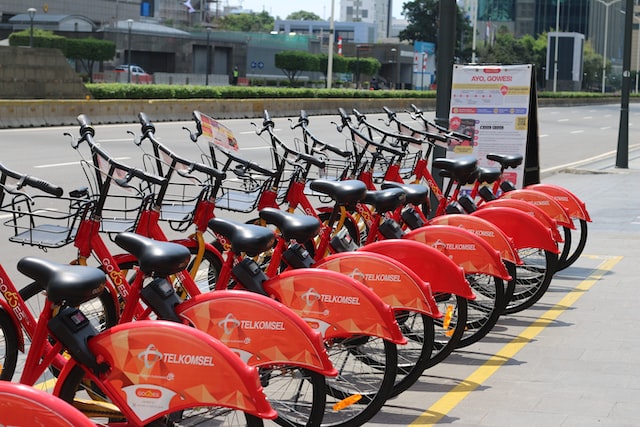
Public transport is a powerful tool to curb climate emissions and to reduce dependence on private motorized vehicles – not to mention to provide more equitable and affordable access to opportunity for riders. But surprisingly few countries have made public transport part of their climate commitments.
New WRI research takes stock of existing language in country’s commitments to the Paris Climate Agreement, known as Nationally Determined Contributions (NDCs), and identifies opportunities to bring the sector to the fore and connect national and local ambitions.
With global emissions from transport continuing to rise, more robust measures on transport decarbonization are needed by 2030 to limit global warming to 1.5 degrees Celsius, including electrifying vehicles and abating vehicle travel. The transport sector represents around 37% of direct CO2 emissions from end-use fuel combustion. Without meaningful policy interventions, this figure is expected to continue to grow. Sustainable modes of travel — such as public transport, which can move more people per unit of emission than cars and takes up less physical space — can and must play a crucial role in reducing the growth of private motor vehicle use.
We utilize two NDC tracking tools from GIZ and SLOCAT and Climate Watch to assess the inclusion of public transport in mitigation measures and analyze relevant actions. A total of 170 NDC documents representing 196 nations were initially submitted, of which 128 NDCs have since been updated or revised. A total of 100 NDCs mention public transport, but of these only 55 promote mode a shift from private vehicles to public transport; 35 promote electrification of public transport and 16 include measures to adapt public transport to the adverse effects of climate change.
Furthermore, although the informal or semi-informal sector — consisting of taxis or minibuses — is a dominant mode of transport in many low-income countries, only one country, Angola, recognizes the sector in its NDC. No countries identify measures to address emissions from informal vehicles, failing to address potentially the oldest, most polluting and most driven vehicles on the road.
Based on this analysis of NDCs as well as public transport literature reviews and policy practices, we have identified five key opportunities for sub-national governments, city leaders, NGOs and urban planners to leverage public transport as a tool for reducing emissions, elevate discussion on the importance of accessible transport and strengthen climate commitments through more quantifiable measures:
- Commit to mobility action plans and institute robust funding for public transport infrastructure and operations. By using plans such as Sustainable Urban Mobility Plans (SUMPs), a comprehensive planning instrument with broad exchange between stakeholders and planning experts, funding and financial measures for public transit can be linked to targets for abating vehicle travel. Investments in public transport infrastructure are needed, as well as direct support for operations to improve and maintain quality of service.
- Initiate a 100% transition to clean electric bus fleets. Some cities and local governments are proceeding with large-scale fleet electrification. Specific targets for electrification of buses should be set in NDCs and matched with national support to finance, procure and roll out vehicles.
- Advance resilience and adaptation measures for public transport. Public transport infrastructure is expensive but can last for years. As the climate crisis accelerates, adaptation measures should be integrated into new systems to adjust operations and safeguard investments.
- Take a systems approach to urban transport systems. Infrastructure is not the only way to support public transport. In many places, capacity can be expanded within existing infrastructure with increased service, more routes and larger vehicle fleets. Public transport systems should additionally be integrated with safe walking and cycling infrastructure and efforts should disincentivize unnecessary highway building and private vehicle travel. The goal should be to create climate-friendly urban mobility systems.
- Make connections across sectors and support sub-national action. Public transport provides cross-cutting benefits. Governments should work to connect NDCs with appropriate ministries, such as transport and health, as well as tap into the power of cities and states to implement improvements.
The ideal NDC with regards to the transport sector should connect national and sub-national policies, include data on current transport sector emissions and articulate ambitious yet feasible emissions reduction targets. There must be additional non-GHG targets for electrification, mode shift and investments in public transport on the national and sub-national level. Furthermore, it should demonstrate an awareness of the nation’s economic and political context, like addressing the informal or semi-formal sector where relevant. Finally, it should address adaptation measures to prepare for the changes brought by climate change and acknowledge the risks of damage to the transport sector and the second-hand impacts on health, safety and the economy.
This is a critical topic of discussion for policymakers at COP27 and an equally important measure for national leaders to act upon after the global summit, particularly in updating NDCs by 2025. With this year’s ambition “to turn climate pledges into action” we have an important opportunity for raising public transport’s profile in the climate and development agenda.
This project update originally appeared on WRI.org
Anna Kustar is a research assistant for the Urban Mobility program at WRI Ross Center for Sustainable Cities.
Ben Welle is a Director of Integrated Transport & Innovation at WRI Ross Center for Sustainable Cities.
Thet Hein Tun is a Senior Transportation Research Associate at WRI Ross Center for Sustainable Cities.






